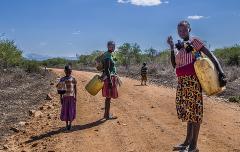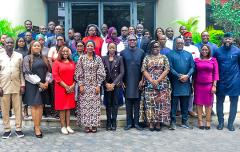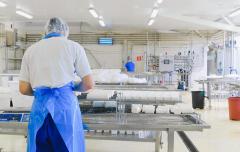Africa’s Cooling Challenge Heats Up As Continent Warms
Africa is not the only place reeling from record high temperatures this summer. Extreme heatwaves are taking a toll in all corners of the world, from California and southern Europe to Japan and South Asia.
But Africa illustrates on a broad scale the negative impacts that extreme heat can have for hundreds of millions of people, especially the poor. Africans living in rural and urban areas face significant risks because they lack access to cooling fans, refrigeration and other forms of cooling that can protect food, vaccines and overall public health.
A new report, Chilling Prospects: Providing Sustainable Cooling for All, quantifies the enormity of the cooling challenge in Africa. It also highlights the opportunities and benefits of providing sustainable, efficient and affordable cooling for vulnerable populations.
The report, authored by Sustainable Energy for All, estimates that over 1.1 billion people globally face immediate risks from lack of access to cooling as global temperatures continue to rise. This includes 470 million people living in rural areas where electricity is largely unavailable, and 630 million people living in crowded cities where electricity is unavailable, unreliable or unaffordable. Nigeria, Sudan and Mozambique are among nine countries in the world most at risk from a lack to cooling due to their large populations, according to the report
Lacking access to cooling can be a life or death issue. Heatwaves already kill an estimated 12,000 people every year and the World Health Organization forecasts that deaths from more extreme heatwaves could grow to 255,000 annually by 2050 if governments do not adapt.
But there are other risks as well. Millions of people face serious health and safety risks every year because they lack refrigeration and cold chains that can preserve perishable food and vaccines. Lack of cooling also means lower incomes for farmers who cannot transport their crops to markets, while reducing economic productivity in cities where heat-related work losses are mounting. Simply put, access to sustainable cooling underpins the ability of millions to realize the Sustainable Development Goals.
To understand the implications for Africa, consider the case of Nigeria, the continent’s most populous country with 186 million people.
For starters, Nigeria is getting hotter; it is expected to experience partial monthly mean temperatures of more than 30 degrees Celsius for 2020-2039 if global warming is not abated. At the same time, an estimated 50 million rural Nigerians lack electricity and basic refrigeration. As a result, they are unlikely to be vaccinated against common diseases and are acutely vulnerable to malnutrition and hunger due to widespread food losses. Nigeria loses more than a third of its agricultural production due to lack of refrigeration.
The report estimates that another 44 million Nigerians living in urban areas face similar risks. Most have little or no access to electricity to refrigerate food or to run cooling devices when urban temperatures soar.
Tackling these challenges is daunting, but the opportunities and benefits that countries can realize by doing so are enormous. For many, access to efficient and affordable cooling can mean a life of prosperity instead of poverty.
One of the biggest challenges is providing clean and efficient cooling systems that do not further exacerbate global warming. As economies grow and global incomes rise, more people will be able to afford air conditioners and refrigerators. But the resulting increase in electricity demand could accelerate global warming if it is powered by fossil fuels or if the appliances are energy inefficient.
The harmful consequences of inefficient air conditioners can be seen in the U.S, which alone consumes as much electricity as the total amount of electricity used by Africa’s population of 1.3 billion people.
Adopting or strengthening energy efficiency performance standards for refrigerators and air conditioners is an important action all countries can take to lower the energy footprint created by cooling demand. The phasing out of refrigerant gases known as HFCs that have high global warming potential, is another important step. This is why 197 countries gathered in Kigali, Rwanda in 2016 to sign the Kigali Amendment of the Montreal Protocol to reduce production and consumption of HFCs by more than 80 percent over the next 30 years.
But affordable, holistic cooling solutions are also needed for people who may not be able to afford air conditioners or lack access to electricity and refrigeration.
The good news is that cost-effective solutions are available today for these populations, although not at the commercial scale that is needed. Affordable off-grid solar systems to power fans and refrigerators are one of the biggest opportunities, especially in remote rural areas. There is also the appearance of cold chain innovations from simple low-tech evaporative coolers being used in Nigeria to more sophisticated solar cooling units being sold in Kenya and South Africa by InspiraFarms.
Cities can utilize simple and cost-effective cooling measures, such as the use of reflective, light-colored roofs and pavements. Studies show these steps alone can lower ambient temperatures by several degrees, which can make a big difference for students a primary school or patients in a hospital. One example where this is being done is the community, !Kheis, in South Africa, where hundreds of homes have been painted with highly reflective coatings.
The challenge is how to scale up promising cooling technologies and strategies so that they reach more people. Making this leap will require strong engagement by government leaders who can identify cooling access gaps in their countries and establish goals for reducing them.
It will also require strong engagement from the private sector, especially the refrigeration, heating and air conditioning sectors. Just as industry had a key role to play in achieving the goals of the Montreal Protocol, they must create major new consumer markets for super-efficient and affordable cooling systems.
Africa in the last few decades has shown the ability to embrace the latest affordable technologies, such as mobile phones and mobile banking, to help solve problems on the ground. It can once again show the way when it comes to cooling.
SEforALL note: This article first appeared in Aspire Africa and can be found here




